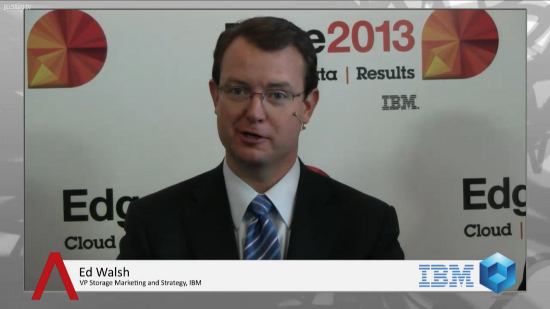 NEWS
NEWS
 NEWS
NEWS
 NEWS
NEWS
Ed Walsh, VP Storage Marketing & Strategy, IBM, discussed software-defined storage and the data trends with theCube co-hosts, John Furrier and Dave Vellante, live at the IBM Edge 2013 conference.
![]()
Talking about the IBM Edge 2013 event being double in size and different in scope compared to last year’s conference, Walsh said that, as it’s been “both partners and clients, so it’s more than a double.” As far as IBM’s strategy goes, he said: “We’re really bringing analytics into the storage layer, which is changing the value proposition.”
“My big take-away is that data processing is now the real deal, but it looks different,” Walsh said. People are always challenged with two things – how they drive data to get more business value and how they manage costs.
Commenting on the current state of virtualization, Walsh explained that “people have all leveled virtualizaiton, but they have different levels of maturity.” When it comes to software defined storage, analytics plays a key role into it, as it’s paramount to help handle the huge amount of existing data. “Flash is fast, it reduces cost, but you can’t be looking at flash other than from a system perspectives, which completely changes the economics.”
“We feel software defined storage 2.0 is open, but also industry-lead,” he added. Comment on their OpenStack involvement, Walsh said IBM is the second contributor after Red Hat, with 150 employees contributing to it. Their big project is OpenDaylight, their software defined network project. Software defined 2.0 works with OpenStack, “it allows people to use our APIs, we’re putting applications directly on the platform. We’re opening up the platform to allow our partners to put things on top of the platform,” Wlash added.
“We believe software defined storage 3.0 is going to be analytics driven and application driven. It has to be open.” Along with a new family of analytics coming on, “in 3.0 you will be able to virtualize your environment,” but analytics will be key. It will allow to analyze copies, see if you need them, determine if they can go into the cloud, etc.
“Right now everyone is moving data over the network, in the future you will move the apps to the data.” The new type of analytics Walsh predicted will create 360-degree views of clients.
After demystifying software-defined storage and determining how it can be leveraged right now, the stage is to make it open and industry-lead, add capabilities. SDS 2.0 allows industry-lead developments into the platform. “You still need a data layer, a data control layer, and we’re opening it up,” Walsh explained.
Asked to point out the biggest misconception about software defines storage, Walsh said “it’s really to think it’s something magical out in the future, we have to demystify it and show people what they can do today, virtualize, get agility and reduce costs.”
Support our mission to keep content open and free by engaging with theCUBE community. Join theCUBE’s Alumni Trust Network, where technology leaders connect, share intelligence and create opportunities.
Founded by tech visionaries John Furrier and Dave Vellante, SiliconANGLE Media has built a dynamic ecosystem of industry-leading digital media brands that reach 15+ million elite tech professionals. Our new proprietary theCUBE AI Video Cloud is breaking ground in audience interaction, leveraging theCUBEai.com neural network to help technology companies make data-driven decisions and stay at the forefront of industry conversations.